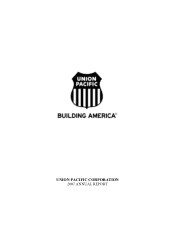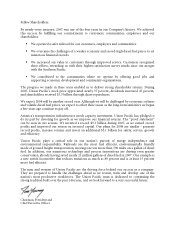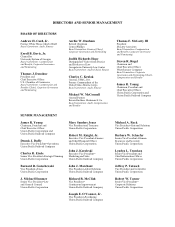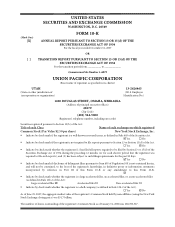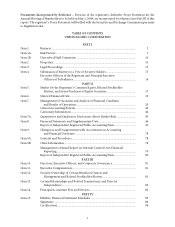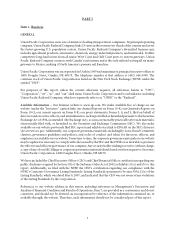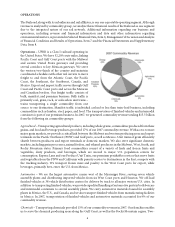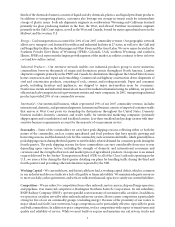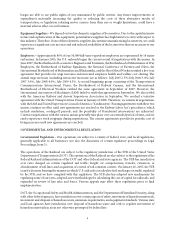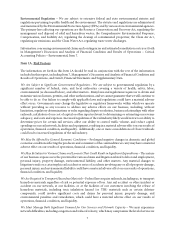Union Pacific 2007 Annual Report Download - page 10
Download and view the complete annual report
Please find page 10 of the 2007 Union Pacific annual report below. You can navigate through the pages in the report by either clicking on the pages listed below, or by using the keyword search tool below to find specific information within the annual report.6
barges are able to use public rights-of-way maintained by public entities. Any future improvements or
expenditures materially increasing the quality or reducing the costs of these alternative modes of
transportation, or legislation releasing motor carriers from their size or weight limitations, could have a
material adverse effect on our business.
Equipment Suppliers – We depend on two key domestic suppliers of locomotives. Due to the capital intensive
nature and sophistication of this equipment, potential new suppliers face high barriers to entry with respect to
this industry. Therefore, if one of these domestic suppliers discontinues manufacturing locomotives, we could
experience a significant cost increase and risk reduced availability of the locomotives that are necessary to our
operations.
Employees – Approximately 86% of our 50,089 full-time-equivalent employees are represented by 14 major
rail unions. In January 2005, the U.S. railroads began the current round of negotiations with the unions. In
June 2007, the Brotherhood of Locomotive Engineers and Trainmen, the Brotherhood of Maintenance of Way
Employees, the Brotherhood of Railway Signalmen, the National Conference of Firemen and Oilers, the
International Brotherhood of Boilermakers and Blacksmiths, and the Sheet Metal Workers ratified a five-year
agreement that provides for wage increases and increased employee health and welfare cost sharing. The
annual wage increases (including retroactive increases) are as follows: July 2005 2.5%; July 2006 3.0%; July
2007 3.0%; July 2008 4.0%; July 2009 4.5%. A second bargaining group consisting of the Transportation
Communications International Union, the Brotherhood of Railway Carman, and the International
Brotherhood of Electrical Workers ratified the same agreement in September of 2007. However, the
International Association of Machinists (IAM) failed to ratify this agreement in September. We also settled
with the American Railway and Airway Supervisors Association in September. We reached a tentative
agreement with the United Transportation Union in January of 2008. Therefore, we remain in negotiations
with the IAM and United Supervisors Council of America (Yardmasters). Existing agreements with these two
unions continue in effect until new agreements are reached or the Railway Labor Act’s procedures (which
include mediation, cooling-off periods, and the possibility of Presidential intervention) are exhausted.
Contract negotiations with the various unions generally take place over an extended period of time, and we
rarely experience work stoppages during negotiations. The current agreements provide for periodic cost of
living increases until new agreements are reached.
GOVERNMENTAL AND ENVIRONMENTAL REGULATION
Governmental Regulation – Our operations are subject to a variety of federal, state, and local regulations,
generally applicable to all businesses (see also the discussion of certain regulatory proceedings in Legal
Proceedings, Item 3).
The operations of the Railroad are subject to the regulatory jurisdiction of the STB of the United States
Department of Transportation (DOT). The operations of the Railroad are also subject to the regulations of the
Federal Railroad Administration of the DOT and other federal and state agencies. The STB has jurisdiction
over rates charged on certain regulated rail traffic; freight car compensation; transfer, extension, or
abandonment of rail lines; and acquisition of control of rail common carriers. On January 26, 2007, the STB
issued a decision limiting the manner in which U.S. railroads can calculate fuel surcharges on traffic regulated
by the STB, and we have complied with this regulation. The STB also has adopted new mechanisms for
regulating some of our rates, adopted a new methodology for calculating the cost of capital for railroads, and
expanded its review of line sales and leases. Various appeals may affect these regulations prior to final
implementation.
DOT, the Occupational Safety and Health Administration, and the Department of Homeland Security, along
with other federal agencies, have jurisdiction over certain aspects of safety, movement of hazardous materials,
movement and disposal of hazardous waste, emissions requirements, and equipment standards. Various state
and local agencies have jurisdiction over disposal of hazardous waste and seek to regulate movement of
hazardous materials in areas not otherwise preempted by federal law.

